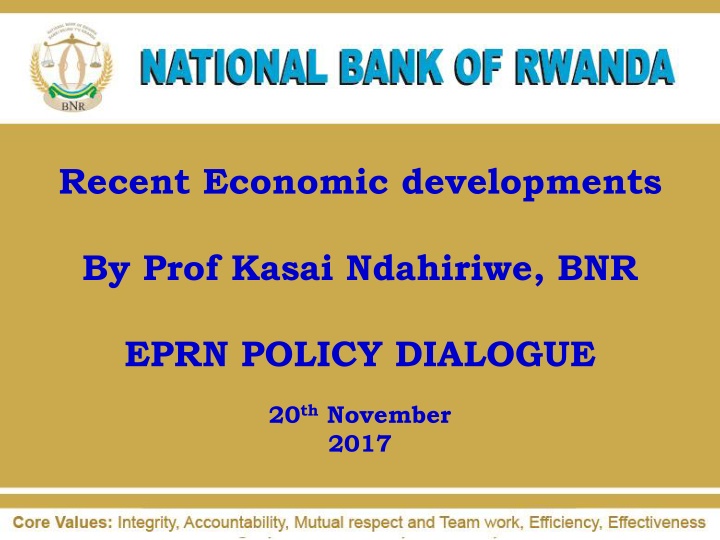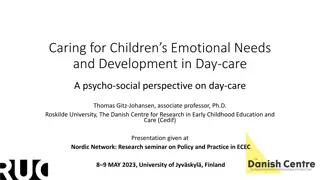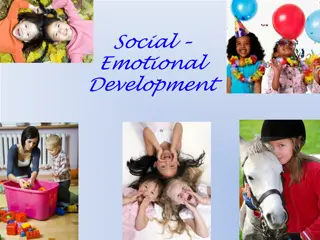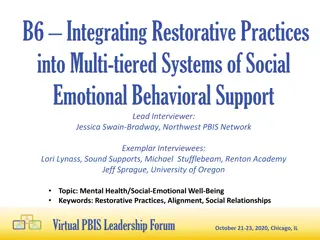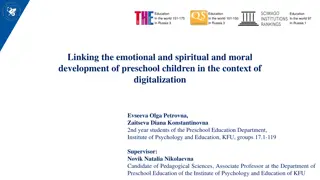Importance of Social-Emotional Learning for Children
Children should have access to social-emotional learning opportunities as it predicts various outcomes. Different assessment methods show varied effectiveness. Approaches to assessment, reporting, resourcing, and implementation are crucial for improving SEL initiatives.
Download Presentation

Please find below an Image/Link to download the presentation.
The content on the website is provided AS IS for your information and personal use only. It may not be sold, licensed, or shared on other websites without obtaining consent from the author.If you encounter any issues during the download, it is possible that the publisher has removed the file from their server.
You are allowed to download the files provided on this website for personal or commercial use, subject to the condition that they are used lawfully. All files are the property of their respective owners.
The content on the website is provided AS IS for your information and personal use only. It may not be sold, licensed, or shared on other websites without obtaining consent from the author.
E N D
Presentation Transcript
Recent Economic developments By Prof Kasai Ndahiriwe, BNR EPRN POLICY DIALOGUE 20thNovember 2017
OUTLINE I. Global economy II. National economic performance III. Outlook
I. GLOBAL ECONOMY In October 2017, the IMF revised up growth forecasts for the global economy to 3.6% from 3.5% forecast in July. GDP growth (%) in selected economies 10.0 8.0 6.0 4.0 2.0 0.0 Q1 Q2 Q3 Q4 Q1 Q2 Q3 Q4 201 5 201 6 201 7 proj. 201 8 proj. 2016 1.4 1.6 6.7 7.2 2017 2.3 2.3 6.7 6.6 Annual Average 2.9 1.5 2.0 1.8 6.9 6.7 8.0 7.1 USA (QoQ) Euro area (YoY) 1.7 China (YoY) India (YoY) 0.8 2.8 1.7 6.7 7.5 1.8 1.9 6.8 7.0 1.2 2.0 6.9 6.1 3.1 2.3 6.9 5.7 2.7 2.1 6.6 7.2 2.2 2.1 6.8 6.7 2.3 1.9 6.5 7.4 6.7 8.6 Source: Bloomberg & IMF, WEO July 2017 Source: Bloomberg & IMF, WEO July 2017
Recovery in Sub-Saharan Africa driven by increasing commodity prices 12.0 SSA GDP growth (%) 10.0 Sub-Saharan Africa Angola Nigeria South Africa 8.0 7.0 6.0 5.3 5.1 5.0 4.3 3.5 4.0 3.4 2.7 2.0 1.3 0.0 -2.0 -4.0 2010 2011 2012 2013 2014 2015 2016 2017 2018 Source: Bloomberg & IMF, WEO July 2017 Source: Bloomberg & IMF, WEO July 2017
In EAC, economic growth remained resilient in the first half of 2017 10 8.9 8.5 9 7.8 7.4 8 6.9 6.8 7 6.2 6.1 5.7 5.7 5.6 5.4 6 5.3 5.3 5.0 4.7 4.5 5 4.2 4.0 4 3.3 2.9 2.8 3 2.3 1.7 2 1 0 Kenya Rwanda Tanzania Uganda 2016 Q1 2016 Q2 2016 Q3 2016 Q4 2017 Q1 2017 Q2
II. NATIONAL ECONOMIC PERFORMANCE Main messages from the recent developments The Rwandan economic performance improved in 2017Q2 11.0 AGRICULTURE, FORESTRY & FISHING INDUSTRY SERVICES Taxes less subsidies on products GROSS DOMESTIC PRODUCT (GDP) 8.9 9.0 7.5 7.0 5.4 5.0 4.0 2.4 3.0 1.7 1.0 -1.0 2016 Q1 2016 Q2 2016 Q3 2016 Q4 2017 Q1 2017 Q2 Expected good performance in 2017Q3 Increasing turnovers of industry and services sectors Increase in commodity prices Agriculture season B good harvest
Leading indicators (CIEA) shows a continued improvement of economic activities Good performance: 2017Q3>2017Q2>2017Q1 But lower on average compared to 2016 19.0 10.0 CIEA 2016 2017 8.9 9.0 17.0 18.1 18.0 7.1 Q1 7.5 8.0 15.0 14.6 10.3 Q2 7.0 14.6 6.0 5.4 13.0 Q3 12.4 13.2 13.2 5.0 12.4 4.0 11.0 Jan.-Sep. 14.9 10.3 4.0 RCIEA RGD 10.3 3.0 2.4 9.0 1.7 2.0 7.0 1.0 7.2 6.9 5.0 - Q1 Q2 Q3 Q4 Q1 Q2 Q3 2016 2017
II. NATIONAL ECONOMIC PERFORMANCE: ECONOMIC ACTIVITIES IN 2017 B. Turnovers of industry and services: +14.6% from +11.8% Jan-Aug; +12.1% from 14.3% Jul-Aug % change Jan.-Aug 2016 Industry sector s good performance led: Mining supported by increase in prices: Cassiterite; +18.6% Wolfram: + 10.7% Good developments in Manufacturing: Increasing cement production Industrial products imports: +19.8% from 11.5% Energy sectorstill performing well due to recent new plants Services sector s good performance led: Trade; Petroleum companies Following increase in pump prices Increase in re-exports (+43.7% from +23.5%) Transport supported by Rwandair good performance following new aircraft & new destination (+60.6%) Banks 2016Q3 (2m) 2017Q3 (2m) Jan.-Aug 2017 Total turnovers 14.3 12.1 11.8 14.6 Industries 25.0 -15.0 10.3 61.2 54.5 10.6 8.9 -1.7 26.8 14.6 11.5 -32.6 17.3 30.8 12.7 -31.6 13.2 64.6 11.6 11.6 7.3 7.6 14.1 17.1 11.7 -9.2 17.1 24.5 Mining & Quarrying Manufacturing Energy Sector Construction Services Wholesale and Retail trade 18.2 0.2 14.0 19.7 Petroleum distributors 15.7 21.6 18.3 16.4 Transport and Storage 16.6 9.5 -3.7 -4.2 10.0 0.3 16.2 10.8 13.6 0.4 7.4 -1.5 Hotels and Restaurants Hotels Information and Comm. 14.4 12.8 40.1 13.1 10.2 -43.7 25.7 13.2 12.8 10.9 10.9 -17.5 Financial & insurance Banks Real Estate Activities
Trade balance developments Trade deficit reduced by 22.6%, from USD 1302.10 million to USD 1007.0 million Jan September 2017 compared to the same period of 2016 Formal Exports +47.0% compared to 2.3% Formal Imports -5.4% compared to -0.1% Exports/Imports coverage from 24.8% to 38.6%. 2015 2016 Jan-Sept. 2016 430.71 2.3 1733.46 -0.1 -1302.7 Jan-Sept. 2017 633.01 47.0 1640.03 -5.4 -1007.0 558.7 -6.85 2311.2 -3.17 -1752.5 598.7 7.16 2248.5 -2.71 -1649.8 Formal exports % change Formal imports % change Trade deficit Imports cover rate 24.2 26.6 24.8 38.6
Traditional Exports Value Share: 31.0% --- volume Share: 9.3% Other Exports Value Share: 35.3% --- volume Share: 39.6% Re-Exports Value Share: 33.7 % --- volume Share: 51.1% Exports: % share Exports FOB in millions USD 60.0 700.0 600.0 50.0 500.0 40.0 400.0 30.0 300.0 20.0 200.0 100.0 10.0 0.0 0.0 2014 2015 2016 Jan-Sept. 2016 Jan-Sept. 2017 2014 2015 2016 Jan-Sept. 2016 Jan-Sept. 2017 Traditional exports Re-exports Other export Traditional exports Re-exports Other export
Consumer Goods Value Share: 33.5 % --- volume Share: 36.9% Capital Goods Value Share: 28.7 % --- volume Share: 3.2 % Intermediary Goods Value Share: 26.6 % --- volume Share: 44.3% Energy and Lubricants Value Share: 11.3% --- volume Share: 15.7 % Imports CIF in millions USD Imports % share 40 3000.00 35 2500.00 30 2000.00 25 1500.00 20 1000.00 15 10 500.00 5 0.00 2013 2014 2015 2016 Jan-Aug Jan-Aug 17 0 16 2013 2014 2015 2016 Capital goods Jan-Aug 16Jan-Aug 17 Consumer goods Capital goods Consumer goods Intermediary goods Enery and lubricants Intermediary goods Enery and lubricants
Easing exchange rate pressures Pressure on exchange rate continued to ease with 2.63% against USD on 17th Nov due to: Reduction in import bill; Reduction in demand for dollars by big companies like RwandAir; Improved export receipts in line with recovery in international commodity prices; Depreciation of Frw against Usd 8.4 9.0 8.0 8.0 6.1 7.0 6.0 4.8 5.0 4.0 3.5 4.0 2.8 2.2 3.0 2.0 1.8 1.5 1.3 1.0 2.0 0.9 0.9 0.8 0.5 0.2 1.0 0.0 Jan Feb Mar Apr May Jun Jul Aug Sep 2016 2017 Expected depreciation of FRW(2017): 3% maximum 12
INFLATION DEVELOPMENTS Headline and core inflation have eased Headline: 7.7% in 2017Q1, 6.2% in 2017Q2, 3.5% in 2017Q3, 3.6% in Oct. Core: 5.5% in 2017Q1, 4.6% in 2017Q2, 3.1% in 2017Q3 and 2.9% in Oct 9 8 7 6 5 4 3 2 1 0 Oct-15 Apr-16 Oct-16 Apr-17 Oct-17 Sep-16 Sep-17 Mar-16 Jun-16 Jul-16 Mar-17 Jun-17 Jul-17 Nov-15 Nov-16 Dec-15 Jan-16 Dec-16 Jan-17 May-16 May-17 Feb-16 Feb-17 Aug-16 Aug-17 Headline Core 5% Objective 8% Ceiling 2% Lower band
Monetary policy stance: overview BNR maintained an accommodative monetary policy stance: The policy rate was reviewed down twice since 2016 from 6.5% to 6.25% in Dec 2016 and to 6% in June 2017. BNR aimed to: Encourage banks to continue supporting the financing of the economy; Improve banks liquidity. 14
I. Monetary developments Outcome of the monetary policy stance M3 growth increased to 9.6% in September 2017 from 7.6% in Dec 2016 Slowdown in economic activities Contribution to M3 growth in % 40.0 30.0 21.1 20.0 19.0 15.6 14.1 10.0 9.6 7.6 0.0 2012 2013 2014 2015 2016 Sep17/Dec16 -10.0 -20.0 NFA NDA M3
Monetary policy stance: hindrances Slowdown in NAL and stock of CPS due to: Increase in NPLs ratio: 8.2% by end Sept.17 from 7.5% by end Dec.16; Lower demand of loans as result of subdued economic activities. 45.0 40.0 39.0 34.8 38.2 35.0 30.0 30.0 25.0 20.0 19.6 15.0 13.7 12.1 11.1 10.0 9.6 9.1 5.3 5.0 5.7 9.3 6.3 0.0 2012 2012 2014 2015 2016 Sep16/Dec15 Sep17/Dec16 New authorized loans growth in % CPS stock growth in % 16
Interest rate developments Due to improved liquidity management, money market interest rates have been recently declining and remaining close to the KRR. 12.0 10.0 8.0 6.0 4.0 2.0 0.0 Repo_rate KRR Interbank_rate T-brate_28days W.T-bills_rate Market interest rates (% average) 2017 July 17.60 7.66 9.94 2012 2013 2014 2015 2016 Q1 17.03 7.48 9.55 Q2 17.11 8.11 9.00 Aug 17.30 7.67 9.63 Sep 17.33 7.86 9.47 Lending Deposit Spread 16.70 17.32 8.85 7.85 17.26 8.24 9.02 17.33 8.24 9.09 17.29 7.91 9.38 9.93 7.39
I. Monetary developments Liquidity conditions developments Banks most liquid assets (FRW billion, unless otherwise indicated) Between December 16 and September17: Total most liquid assets:+15.0 % vs -24.3%; Overall improvement was mainly caused by less demand on foreign exchange market due to good performance in external sector.
Money demand Currency in circulation ratio declined since 2016 due to: Ongoing modernization of payment systems Slowdown in economic activities. CIC y-o-y changes CIC/M3 (RHS) 25% 14% 12% 20% 10% 15% 8% 10% 6% 5% 4% 0% 2% -5% 0%
Monetary developments: Interbank market The interbank market remained active in 2017:
ECONOMIC OUTLOOK Real GDP growth to improve Good agricultural production due to good weather improvement in food supply Improvement in services and industry sectors rising trend of CIEA and turnovers Improvement in Credit to the private sector Exchange rate pressures & International oil prices to remain low Aggregate demand & inflation to remain subdued Monetary policy likely to remain accommodative
